| |
|
Follow these journeys as they happen at Last Of England
Twitter.
Laxfield is a large, relatively remote
village, and its church has a surprisingly urban setting,
with its railings onto the wide main street, the shop on
one side, the pub on the other, and the former guildhall
opposite. This could easily be a quiet part of a former
medieval city, Norwich or Bristol, perhaps. That Laxfield
is very much off the beaten track makes it doubly
surprising. Unusually in Suffolk the tower is faced in
stone, the knapped flint has been used only sparingly. It
is reminiscent of Eye, and Sam Mortlock thought his might
be because Eye priory held the living here, although, as
Simon Cotton has pointed out, this tower is a little
older than Eye's. Redenhall church in Norfolk is another
similar tower which is called to mind, and it seems
likely the same masons were involved in all three.
Shields of the Wingfields bear witness to the involvement
of that most influential of families in this part of
Suffolk. The nave is perhaps the work of a century
earlier than the tower, and the disappointingly dumpy
porch is a result of the removal of the upper storey some
time after the Reformation.
As if the stonework of the tower were not singular
enough, the rebuilding of the east end of the nave and of
the entire chancel was carried out in white brick in the
1820s. This is too early for the influence of the
Liturgical Movement of that century to have insisted on
the proper medieval materials, but it is attractive in
its way.
William Dowsing, the great iconoclast, was born in
Laxfield, and retained his family house and land here,
but he spent most of his time at his other houses in
Baylham and Stratford in the south of the county.
Interestingly, the visit to Laxfield church to check it
for Catholic imagery that is recorded in his journal on
Wednesday, 17 July 1644 was in isolation from the rest of
his tour around Suffolk and Cambridgeshire's churches.
This suggests that he was already in the area for other
reasons, perhaps connected with collecting rents on land
he owned in the parish.
Dowsing found rather more at Laxfield to disapprove of
than he had in many churches elsewhere. There were angels
and crosses on the roof and porch, images in stained
glass, possibly a stone carving or two, possibly two
bench ends of evangelistic symbols, and brass
inscriptions indicative of Catholic practice. He also
ordered the chancel steps to be levelled. These had been
recently uplifted as part of the Laudian reforms, which
the Puritans thought suspiciously Catholic. Laud would be
beheaded six months after Dowsing's visit here. Dowsing
entrusted the work here to his nephew in the village,
also called William Dowsing, one of numerous Dowsings in
17th Century Laxfield, and there is still a Dowsing Farm
in the neighbourhood. The younger William and his wife
Sybil are buried under ledger stones in the church.
Dowsing is often accused of being solely responsible for
the wrecking of Suffolk's churches, which, quite plainly,
he wasn't. The great holocaust of Suffolk church
interiors had been carried out a century earlier, by
Anglican vandals in the last years of Henry VIII, and
under the thankfully brief fundamentalist regime of the
boy-king Edward VI. This was when altars and statues were
smashed, rood-lofts and images torn down, vestments and
mass-books thrown on to bonfires, gold and silver plate
looted and melted down. Much of this was likely to have
been carried out by mobs in a drunken frenzy. Dowsing's
was a mopping-up operation, checking for 'that which was
not formerly removed'. His hit-list was the chancel steps
recently introduced by Laud, images in stained glass
(many of these had survived the Anglican reformers,
because of the sheer inconvenience of replacing them),
angels on the roof beams, crosses and statues in
inaccessible places, and brass inscriptions referring to
the cult of the dead. Occasionally, he circumscribed a
font, as at Hacheston.
This is interesting, because in three of the Suffolk
churches he visited, Badingham, Cratfield and here, at
Laxfield, there survive three of the finest seven
sacrament fonts in the kingdom. These fonts are the
height of Catholic imagery, and were produced at the
highest moment of Catholic popularity and practice in the
middle of the 15th century. Why did Dowsing not destroy
them? Perhaps he felt that simply mutilating them was
enough, although he does not mention doing this, and
there is some evidence that this had occured 100 years
before. Perhaps he did not think them superstitious, in
the sense that worship was unlikely to be offered to
them. This was probably how the font cover at Ufford
survived, presuming the statuettes had been removed
before he got there. Most likely of all, they were
hammered flush, and plastered over, a century before
Dowsing's visit.
The first impression on entering this great church is its
sheer size. There are no aisle, no clerestory, just a
vast roof spanning 36 feet across the mighty space, one
of the widest in Suffolk. Hemmed in by doored pews set at
a camber at the west end is the Seven Sacraments font, a
breath-taking object. If this was in the V&A in
London, people would happily travel just to see it. It is
set at the centre of a great Maltese cross, the gaps
between the arms of the cross intended for priest and
baptismal party. The bowl has no shaft and is set
directly on the base.
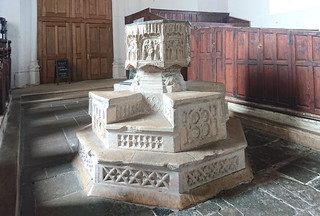
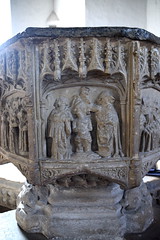 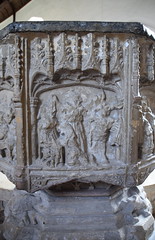  
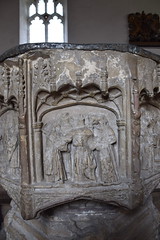  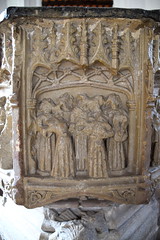 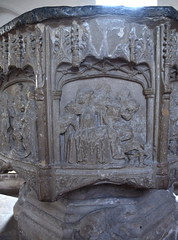
The seven sacraments are set in arcades. The
north-east panel shows the baptism of Christ, and then
the others, in clockwise order, are matrimony, baptism,
ordination, confirmation, mass, confession and last
rites. It is common for the odd-panel-out to face east or
west, so this bowl may have been moved at some point. It
would be fair to say that the scenes are not as intricate
or artistically fine as at neighbouring Cratfield, as
characterful as at Badingham as close in the other
direction, as mysterious as Westhall. But they are very
fine, and probably have more in common with Westhall than
the others. Simon Cotton tells me that will evidence
dates this font to the 1460s.
The banked sets of early 19th Century box seats in the
north-west and south-west corners of the nave were
intended for scholars, and you can still make out the
labels on them. You can see something similar on the
other side of Suffolk at Kedington. There are other good
benches from a century or so either side of the
Reformation, although not much survives of medieval
evidence. Traces of paint at the east end of the mighty
roof suggest that there was once a canopy of honour to
the rood here. Unlike at nearby Metfield, it was painted
directly onto the beams. Above the west door there is an
unusual plaster royal arms of Queen Anne. Francis Spear's
crucifixion in the east window is a suitably striking end
to the view down the drama of this grand space.
And there are the little details. Look at the reading
desk in front of the pulpit. It must date from the late
17th or early 18th centuries, but the two supporting
figures are exotic in the extreme. They depict two buxom
figures, typical subjects of the time on domestic
furnishings, but they do not appear to have been reused
from elsewhere. It is tempting to think of them as pagan,
but they are more likely the work of a local carver.
Perhaps he had visited the south seas on a trading ship
in his youth, and had never forgotten it.
Simon Knott, April 2019
Follow these journeys as they happen at Last Of England
Twitter.
|
|
|

